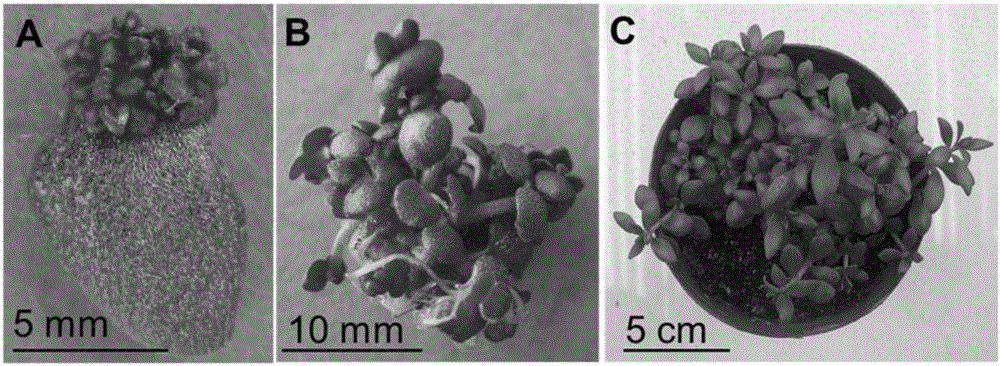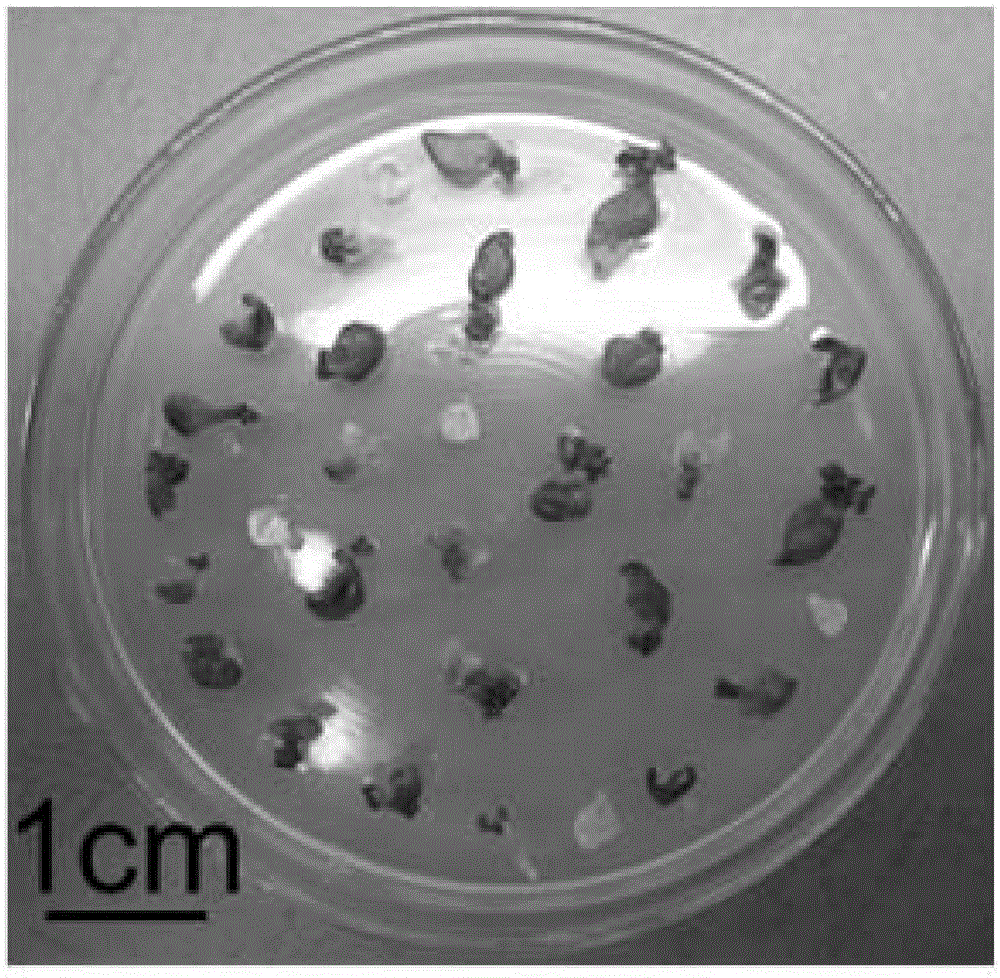Molecular breeding method fast obtaining large number of transgenosis sedum lineare new species
A molecular breeding and transgenic technology, applied in genetic engineering, plant genetic improvement, botanical equipment and methods, etc., can solve the problems of cumbersome processing, poor phenotype predictability, low efficiency, etc., and achieve the effect of high-efficiency regeneration system and simple operation
- Summary
- Abstract
- Description
- Claims
- Application Information
AI Technical Summary
Problems solved by technology
Method used
Image
Examples
Embodiment 1
[0043] Embodiment 1: the acquisition of sterile vaccine
[0044] Bought from the market, take the well-grown twigs, rinse them with tap water, soak them in 0.1% carbendazim solution for 5-10 minutes, take them out, rinse them with tap water, and cut the branches into About 5 cm in length. Soak in 75% alcohol aqueous solution for 30 seconds, then rinse with sterile water for 3 times, move the branches into 2.5% sodium hypochlorite solution (adding mass fraction of 0.05% Tween 80) for disinfection for 10 minutes, rinse with sterile water for 6 and then place the shoots on sterile filter paper to blot dry. The shoots were cut into sections with one node, and then inoculated into 1 / 2MS medium one by one. Placed at a temperature of 25±1°C and an illumination of 50 μmolm –2 the s –1 , cultivated under the condition of light 12h / day. After culturing for about 20 days, the leaf axils elongate and develop into buds, and adventitious roots grow from the incision at the contact medi...
Embodiment 2
[0045] Embodiment 2: the acquisition of regeneration plant
[0046] Cut leaves, petioles, and stem nodes from sterile seedlings as explants, and inoculate them in bud induction medium (MS medium adds 1mgl -1 benzyladenine (BA) and 0.1mgl -1 a-Naphthalene acetic acid (NAA), pH 5.8), placed at a temperature of 25±2°C, with an illumination of 50 μmolm –2 the s –1 , cultivated under the condition of light 12h / day. When cultivating for 16 days, more than 95% of the explants' cuts can be observed to have regeneration shoots ( figure 1 A), the leaf explants with regenerated shoots were cultured under light for 16 days and transferred to the same fresh shoot induction medium and continued to be cultivated under the same conditions. It can be seen that a large number of regenerated shoots developed ( figure 1 B), the regenerated buds are transferred to the grafting elongation medium (1 / 2MS medium, pH is 5.8) and cultivated under the same conditions, the buds are elongated and devel...
Embodiment 3
[0048] Embodiment 3: be used for the cultivation of the S. japonica explant of transformation
[0049] Take 21 days as one subculture, continuously cut off 2cm high bud branches and transfer them to 1 / 2MS medium for cultivation under the same conditions, and multiply the aseptic seedlings; cut leaves, petioles, and stem nodes from the aseptic seedlings as explants body for Agrobacterium tumefaciens infection.
PUM
| Property | Measurement | Unit |
|---|---|---|
| quality score | aaaaa | aaaaa |
Abstract
Description
Claims
Application Information
 Login to View More
Login to View More - R&D
- Intellectual Property
- Life Sciences
- Materials
- Tech Scout
- Unparalleled Data Quality
- Higher Quality Content
- 60% Fewer Hallucinations
Browse by: Latest US Patents, China's latest patents, Technical Efficacy Thesaurus, Application Domain, Technology Topic, Popular Technical Reports.
© 2025 PatSnap. All rights reserved.Legal|Privacy policy|Modern Slavery Act Transparency Statement|Sitemap|About US| Contact US: help@patsnap.com



